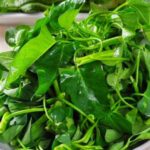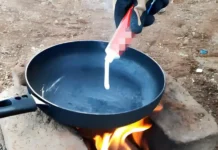1. Rinse Vegetables with Diluted Salt Water
When you buy vegetables, don’t just rinse them with tap water. Take an extra step by soaking them in diluted salt water. Back in 2006, Chinese scientists conducted a study proving that salt water effectively removes pesticides from produce.
To wash your fruits and veggies this way, mix one part salt with ten parts water and soak the produce for about 10-15 minutes. Afterward, rinse them with tap water, and you’re good to go.
2. Use Your Finger to Measure Water for Cooking Rice
This tip is probably familiar to many of us. There’s no need to measure the exact amount of rice and water as instructed on the rice bag. Simply wash the rice, put it in the pot, spread it evenly, and add water until it reaches the first joint of your finger when you poke it perpendicular to the surface of the rice.
3. Use Cornstarch as a Thickening Agent for a Glossy Finish

For braised or stir-fried dishes, add a little cornstarch (mix about 5 grams of cornstarch with 20-40 ml of water) to give your dishes a glossy, mouthwatering appeal! Not only will it thicken the sauce, but it’ll also make your food look extra delicious.
4. Use Egg Yolk to Tenderize Meat
Some cuts of meat tend to be tough due to the presence of tendons. If you’re looking for a way to tenderize these meats, try brushing them with egg yolk and letting them sit for about 15 minutes. This is a secret trick used by many Chinese chefs.
It might sound unconvincing, as we often use acidic ingredients like lemon juice or vinegar to tenderize meat. However, Chinese chefs explain that egg yolk not only enhances the color of the meat but also creates a protective layer that prevents the loss of moisture and nutrients during cooking, resulting in softer and tastier meat.
5. Blanch Meat in Boiling Water Before Cooking
Don’t just rinse your meat and start cooking. Instead, blanch the meat in boiling water (100°C) for 2-3 minutes. Many people think that this step might reduce the nutritional value or natural sweetness of the meat, but that’s not the case.
Blanching helps remove any remaining impurities, dried blood, or bacteria from the surface of the meat that regular washing might not eliminate. Additionally, it makes the meat tender and more receptive to absorbing flavors during stir-frying or braising.
6. Steam Instead of Boil
Boiling meat and vegetables is a common cooking method for many homemakers. However, boiling can lead to a loss of essential nutrients if you don’t use the boiling water afterward.
Steaming is a better alternative as it cooks your food while retaining the natural sweetness and maximum nutritional value.
7. Use Fruits as Natural Sweeteners
.
Instead of using sugar, condensed milk, or other sweeteners when baking or making desserts, try using fruits! Some great options for natural sweetness in your baked goods or milk-based desserts include dates and raisins.
Reducing the intake of sugar and dairy products not only helps with weight management but also slows down the aging process of your skin.
There you have it—seven simple tips to make your time in the kitchen more enjoyable and healthier! Remember these tricks to make every cooking session feel like a breeze and contribute to a healthier lifestyle.
According to Nhịp Sống Việt
The Ultimate Guide to Buying Bánh Chưng: Uncover the Secrets to Identifying High-Quality Treats
The traditional Vietnamese delicacy, Banh Chung, is often enjoyed during Lunar New Year celebrations, but consumers must be wary of the toxic variety cooked with battery acid. This harmful version can cause serious health issues, so it is imperative that buyers are vigilant and discerning when making their purchases to ensure they are acquiring the authentic, safe-to-consume Banh Chung.






































